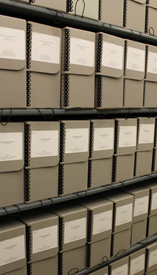An Introduction
by Kevin Proffitt
Senior Archivist for Research & Collections, American Jewish Archives

A Jewish community has existed in America for more than three centuries. In the year 1654 a handful of Jews--twenty-three in all--disembarked at New Amsterdam, the tiny Dutch settlement at the mouth of the Hudson River, and established the first Jewish community in what is now the United States. By the year 1990, the American Jewish community has grown to number nearly six million.
How this growth was accomplished, what it meant to those who were involved in it and to the land which fostered it, the enormous importance it came to possess for the Jewish communities of the world—this is surely one of the most remarkable and significant stories both in American and in Jewish history. It is a story that scholars of today and tomorrow will explore in great depth. It is also a story of family life; a search for "roots", identity and family history. It is a story of a group of people and their lives: their work, their beliefs, their failures, their successes. Most of all, it is part of the American story. Those who lack an understanding of the American Jewish experience will, ultimately, lack an understanding of the American dream and the Jewish heritage.
To discover and tell this story requires more than dedication and discipline. It requires documentary sources—the raw material of history. When such resources are scarce—and this is often the case—researchers find themselves greatly handicapped. Where is this raw material to be found, and how is it to be made available to historians, genealogists, sociologists—anyone who is interested in the study of American Jewry? In many ways it is safe to say that no agency within the American Jewish community is a better source for these materials than the American synagogue.
So much of American Jewish religious life has been, and still is, reflected in the synagogue, the basic institution of American Jewry. Congregational records constitute one of the most important sources of American Jewish life and thought that can be found. The American Jewish Archives hopes the information presented here will encourage American synagogues to organize their own congregational archives, if they have not already done so, and guide them as they embark on this important enterprise.1
Proper planning and organization are essential to the creation of a congregational archives. Required is a commitment to the task, an attention to detail, and knowledge of basic archival principles. Many decisions must be made. The mission and goals of the archives must be decided. A collection policy must be established. Sources of funding identified. Staffing must be arranged. Supplies and a storage area obtained.
This manual includes six broad areas of emphasis that should provide the fundamentals of starting a congregational archives. These areas can be adapted to meet individual congregational needs. Taken together, they will provide a solid basis on which to start and build a usable and efficient archives. The six areas of emphasis, and supplementary material are:
NOTE: Included throughout this manual, in the footnotes and the appendix, are suggestions for further reading. These should be consulted for clarification and support as the manual is read and used. They can also be used as a beginning for further study. This manual covers only the basics of archival work. As your experience grows and needs change, the reading and examples listed here can direct you to new sources of material concerning advanced theories, methods and procedures. Examples of all forms and regulations mentioned in this brochure can be obtained by contacting the Office of the Archivist of the American Jewish Archives:
Starting From Scratch may be downloaded in its entirety.
If you have questions, please email Kevin Proffitt. Please include a mailing address in your inquiry.
|